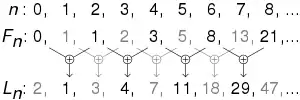
The Lucas sequence is an integer sequence named after the mathematician François Édouard Anatole Lucas (1842–1891), who studied both that sequence and the closely related Fibonacci sequence. Individual numbers in the Lucas sequence are known as Lucas numbers. Lucas numbers and Fibonacci numbers form complementary instances of Lucas sequences.
The Lucas sequence has the same recursive relationship as the Fibonacci sequence, where each term is the sum of the two previous terms, but with different starting values.[1] This produces a sequence where the ratios of successive terms approach the golden ratio, and in fact the terms themselves are roundings of integer powers of the golden ratio.[2] The sequence also has a variety of relationships with the Fibonacci numbers, like the fact that adding any two Fibonacci numbers two terms apart in the Fibonacci sequence results in the Lucas number in between.[3]
The first few Lucas numbers are
- 2, 1, 3, 4, 7, 11, 18, 29, 47, 76, 123, 199, 322, 521, 843, 1364, 2207, 3571, 5778, 9349, ... . (sequence A000032 in the OEIS)
which coincides for example with the number of independent vertex sets for cyclic graphs of length .[1]
Definition
As with the Fibonacci numbers, each Lucas number is defined to be the sum of its two immediately previous terms, thereby forming a Fibonacci integer sequence. The first two Lucas numbers are and , which differs from the first two Fibonacci numbers and . Though closely related in definition, Lucas and Fibonacci numbers exhibit distinct properties.
The Lucas numbers may thus be defined as follows:
(where n belongs to the natural numbers)
All Fibonacci-like integer sequences appear in shifted form as a row of the Wythoff array; the Fibonacci sequence itself is the first row and the Lucas sequence is the second row. Also like all Fibonacci-like integer sequences, the ratio between two consecutive Lucas numbers converges to the golden ratio.
Extension to negative integers
Using , one can extend the Lucas numbers to negative integers to obtain a doubly infinite sequence:
- ..., −11, 7, −4, 3, −1, 2, 1, 3, 4, 7, 11, ... (terms for are shown).
The formula for terms with negative indices in this sequence is
Relationship to Fibonacci numbers

The Lucas numbers are related to the Fibonacci numbers by many identities. Among these are the following:
- , so .
- ; in particular, , so .
Their closed formula is given as:
where is the golden ratio. Alternatively, as for the magnitude of the term is less than 1/2, is the closest integer to or, equivalently, the integer part of , also written as .
Combining the above with Binet's formula,
a formula for is obtained:
For integers n ≥ 2, we also get:
with remainder R satisfying
- .
Lucas identities
Many of the Fibonacci identities have parallels in Lucas numbers. For example, the Cassini identity becomes
Also
where .
where except for .
For example if n is odd, and
Checking, , and
Generating function
Let
be the generating function of the Lucas numbers. By a direct computation,
which can be rearranged as
gives the generating function for the negative indexed Lucas numbers, , and
satisfies the functional equation
As the generating function for the Fibonacci numbers is given by
we have
which proves that
and
proves that
The partial fraction decomposition is given by
where is the golden ratio and is its conjugate.
This can be used to prove the generating function, as
Congruence relations
If is a Fibonacci number then no Lucas number is divisible by .
is congruent to 1 modulo if is prime, but some composite values of also have this property. These are the Fibonacci pseudoprimes.
is congruent to 0 modulo 5.
Lucas primes
A Lucas prime is a Lucas number that is prime. The first few Lucas primes are
- 2, 3, 7, 11, 29, 47, 199, 521, 2207, 3571, 9349, 3010349, 54018521, 370248451, 6643838879, ... (sequence A005479 in the OEIS).
The indices of these primes are (for example, L4 = 7)
- 0, 2, 4, 5, 7, 8, 11, 13, 16, 17, 19, 31, 37, 41, 47, 53, 61, 71, 79, 113, 313, 353, 503, 613, 617, 863, 1097, 1361, 4787, 4793, 5851, 7741, 8467, ... (sequence A001606 in the OEIS).
As of September 2015, the largest confirmed Lucas prime is L148091, which has 30950 decimal digits.[4] As of August 2022, the largest known Lucas probable prime is L5466311, with 1,142,392 decimal digits.[5]
If Ln is prime then n is 0, prime, or a power of 2.[6] L2m is prime for m = 1, 2, 3, and 4 and no other known values of m.
Lucas polynomials
In the same way as Fibonacci polynomials are derived from the Fibonacci numbers, the Lucas polynomials are a polynomial sequence derived from the Lucas numbers.
Continued fractions for powers of the golden ratio
Close rational approximations for powers of the golden ratio can be obtained from their continued fractions.
For positive integers n, the continued fractions are:
- .
For example:
is the limit of
with the error in each term being about 1% of the error in the previous term; and
is the limit of
with the error in each term being about 0.3% that of the second previous term.
Applications
Lucas numbers are the second most common pattern in sunflowers after Fibonacci numbers, when clockwise and counter-clockwise spirals are counted, according to an analysis of 657 sunflowers in 2016.[7]
See also
References
- 1 2 Weisstein, Eric W. "Lucas Number". mathworld.wolfram.com. Retrieved 2020-08-11.
- ↑ Parker, Matt (2014). "13". Things to Make and Do in the Fourth Dimension. Farrar, Straus and Giroux. p. 284. ISBN 978-0-374-53563-6.
- ↑ Parker, Matt (2014). "13". Things to Make and Do in the Fourth Dimension. Farrar, Straus and Giroux. p. 282. ISBN 978-0-374-53563-6.
- ↑ "The Top Twenty: Lucas Number". primes.utm.edu. Retrieved 6 January 2022.
- ↑ "Henri & Renaud Lifchitz's PRP Top - Search by form". www.primenumbers.net. Retrieved 6 January 2022.
- ↑ Chris Caldwell, "The Prime Glossary: Lucas prime" from The Prime Pages.
- ↑ Swinton, Jonathan; Ochu, Erinma; null, null (2016). "Novel Fibonacci and non-Fibonacci structure in the sunflower: results of a citizen science experiment". Royal Society Open Science. 3 (5): 160091. Bibcode:2016RSOS....360091S. doi:10.1098/rsos.160091. PMC 4892450. PMID 27293788.
External links
- "Lucas polynomials", Encyclopedia of Mathematics, EMS Press, 2001 [1994]
- Weisstein, Eric W. "Lucas Number". MathWorld.
- Weisstein, Eric W. "Lucas Polynomial". MathWorld.
- "The Lucas Numbers", Dr Ron Knott
- Lucas numbers and the Golden Section
- A Lucas Number Calculator can be found here.
- OEIS sequence A000032 (Lucas numbers beginning at 2)
